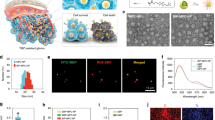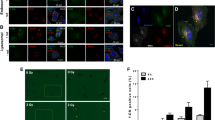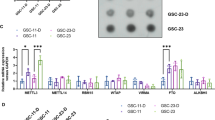Abstract
Glioblastoma multiforme (GBM) is one of the most formidable brain tumors with a mean survival period of approximately 12 months. To date, a combination of radiotherapy and chemotherapy with an oral alkylating agent, temozolomide (TMZ), has been used as first-line therapy for glioma. However, the efficacy of chemotherapy for treating GBM is very limited; this is partly because of the high activity levels of the DNA repair protein O6-methylguanine-DNA methyltransferase (MGMT) in tumor cells, which creates a resistant phenotype by blunting the therapeutic effect of alkylating agents. Thus, MGMT may be an important determinant of treatment failure and should be considered as a suitable target for intervention, in an effort to improve the therapeutic efficacy of TMZ. In this study, we showed that small-interfering RNA (siRNA)-based downregulation of MGMT could enhance the chemosensitivity of malignant gliomas against TMZ. Notably, TMZ-resistant glioma-initiating cells with increased DNA repair and drug efflux capabilities could be efficiently transduced with MGMT-siRNA by using a novel liposome, LipoTrust. Accordingly, such transduced glioma-initiating cells could be sensitized to TMZ in both in vitro and in vivo tumor models. Taken together, this study provides an experimental basis for the clinical use of such therapeutic combinations.
This is a preview of subscription content, access via your institution
Access options
Subscribe to this journal
Receive 12 print issues and online access
$259.00 per year
only $21.58 per issue
Buy this article
- Purchase on Springer Link
- Instant access to full article PDF
Prices may be subject to local taxes which are calculated during checkout





Similar content being viewed by others
References
Stupp R, Mason WP, van den Bent MJ, Weller M, Fisher B, Taphoorn MJ et al. Radiotherapy plus concomitant and adjuvant temozolomide for glioblastoma. N Engl J Med 2005; 352: 987–996.
Day III RS, Ziolkowski CH, Scudiero DA, Meyer SA, Lubiniecki AS, Girardi AJ et al. Defective repair of alkylated DNA by human tumour and SV40-transformed human cell strains. Nature 1980; 288: 724–727.
Gerson SL . MGMT: its role in cancer aetiology and cancer therapeutics. Nat Rev Cancer 2004; 4: 296–307.
Lee J, Kotliarova S, Kotliarov Y, Li A, Su Q, Donin NM et al. Tumor stem cells derived from glioblastomas cultured in bFGF and EGF more closely mirror the phenotype and genotype of primary tumors than do serum-cultured cell lines. Cancer Cell 2006; 9: 391–403.
Singh SK, Hawkins C, Clarke ID, Squire JA, Bayani J, Hide T et al. Identification of human brain tumour initiating cells. Nature 2004; 432: 396–401.
Bao S, Wu Q, McLendon RE, Hao Y, Shi Q, Hjelmeland AB et al. Glioma stem cells promote radioresistance by preferential activation of the DNA damage response. Nature 2006; 444: 756–760.
Liu G, Yuan X, Zeng Z, Tunici P, Ng H, Abdulkadir IR et al. Analysis of gene expression and chemoresistance of CD133+ cancer stem cells in glioblastoma. Mol Cancer 2006; 5: 67.
Yuki K, Natsume A, Yokoyama H, Kondo Y, Ohno M, Kato T et al. Induction of oligodendrogenesis in glioblastoma-initiating cells by IFN-mediated activation of STAT3 signaling. Cancer Lett 2009; 284: 71–79.
Challen GA, Little MH . A side order of stem cells: the SP phenotype. Stem Cells 2006; 24: 3–12.
Hirschmann-Jax C, Foster AE, Wulf GG, Nuchtern JG, Jax TW, Gobel U et al. A distinct ‘side population’ of cells with high drug efflux capacity in human tumor cells. Proc Natl Acad Sci USA 2004; 101: 14228–14233.
Patrawala L, Calhoun T, Schneider-Broussard R, Zhou J, Claypool K, Tang DG . Side population is enriched in tumorigenic, stem-like cancer cells, whereas ABCG2+ and ABCG2− cancer cells are similarly tumorigenic. Cancer Res 2005; 65: 6207–6219.
Whitehead KA, Langer R, Anderson DG . Knocking down barriers: advances in siRNA delivery. Nat Rev Drug Discov 2009; 8: 129–138.
Dean M, Fojo T, Bates S . Tumour stem cells and drug resistance. Nat Rev Cancer 2005; 5: 275–284.
Kondo T, Setoguchi T, Taga T . Persistence of a small subpopulation of cancer stem-like cells in the C6 glioma cell line. Proc Natl Acad Sci USA 2004; 101: 781–786.
Fruehauf JP, Brem H, Brem S, Sloan A, Barger G, Huang W et al. In vitro drug response and molecular markers associated with drug resistance in malignant gliomas. Clin Cancer Res 2006; 12: 4523–4532.
Ma J, Murphy M, O’Dwyer PJ, Berman E, Reed K, Gallo JM . Biochemical changes associated with a multidrug-resistant phenotype of a human glioma cell line with temozolomide-acquired resistance. Biochem Pharmacol 2002; 63: 1219–1228.
Hermisson M, Klumpp A, Wick W, Wischhusen J, Nagel G, Roos W et al. O6-methylguanine DNA methyltransferase and p53 status predict temozolomide sensitivity in human malignant glioma cells. J Neurochem 2006; 96: 766–776.
Kokkinakis DM, Bocangel DB, Schold SC, Moschel RC, Pegg AE . Thresholds of O6-alkylguanine-DNA alkyltransferase which confer significant resistance of human glial tumor xenografts to treatment with 1,3-bis(2-chloroethyl)-1-nitrosourea or temozolomide. Clin Cancer Res 2001; 7: 421–428.
Srivenugopal KS, Yuan XH, Friedman HS, Ali-Osman F . Ubiquitination-dependent proteolysis of O6-methylguanine-DNA methyltransferase in human and murine tumor cells following inactivation with O6-benzylguanine or 1,3-bis(2-chloroethyl)-1-nitrosourea. Biochemistry 1996; 35: 1328–1334.
Liu L, Gerson SL . Targeted modulation of MGMT: clinical implications. Clin Cancer Res 2006; 12: 328–331.
Kanzawa T, Bedwell J, Kondo Y, Kondo S, Germano IM . Inhibition of DNA repair for sensitizing resistant glioma cells to temozolomide. J Neurosurg 2003; 99: 1047–1052.
Quinn JA, Pluda J, Dolan ME, Delaney S, Kaplan R, Rich JN et al. Phase II trial of carmustine plus O(6)-benzylguanine for patients with nitrosourea-resistant recurrent or progressive malignant glioma. J Clin Oncol 2002; 20: 2277–2283.
Quinn JA, Desjardins A, Weingart J, Brem H, Dolan ME, Delaney SM et al. Phase I trial of temozolomide plus O6-benzylguanine for patients with recurrent or progressive malignant glioma. J Clin Oncol 2005; 23: 7178–7187.
Malone RW, Felgner PL, Verma IM . Cationic liposome-mediated RNA transfection. Proc Natl Acad Sci USA 1989; 86: 6077–6081.
Felgner PL, Ringold GM . Cationic liposome-mediated transfection. Nature 1989; 337: 387–388.
Sato Y, Murase K, Kato J, Kobune M, Sato T, Kawano Y et al. Resolution of liver cirrhosis using vitamin A-coupled liposomes to deliver siRNA against a collagen-specific chaperone. Nat Biotechnol 2008; 26: 431–442.
Bankiewicz KS, Eberling JL, Kohutnicka M, Jagust W, Pivirotto P, Bringas J et al. Convection-enhanced delivery of AAV vector in parkinsonian monkeys; in vivo detection of gene expression and restoration of dopaminergic function using pro-drug approach. Exp Neurol 2000; 164: 2–14.
Hadaczek P, Kohutnicka M, Krauze MT, Bringas J, Pivirotto P, Cunningham J et al. Convection-enhanced delivery of adeno-associated virus type 2 (AAV2) into the striatum and transport of AAV2 within monkey brain. Hum Gene Ther 2006; 17: 291–302.
Krauze MT, Vandenberg SR, Yamashita Y, Saito R, Forsayeth J, Noble C et al. Safety of real-time convection-enhanced delivery of liposomes to primate brain: a long-term retrospective. Exp Neurol 2008; 210: 638–644.
Author information
Authors and Affiliations
Corresponding author
Ethics declarations
Competing interests
The authors declare no conflict of interest.
Rights and permissions
About this article
Cite this article
Kato, T., Natsume, A., Toda, H. et al. Efficient delivery of liposome-mediated MGMT-siRNA reinforces the cytotoxity of temozolomide in GBM-initiating cells. Gene Ther 17, 1363–1371 (2010). https://doi.org/10.1038/gt.2010.88
Received:
Revised:
Accepted:
Published:
Issue Date:
DOI: https://doi.org/10.1038/gt.2010.88
Keywords
This article is cited by
-
Liposome-Mediated Anti-Viral Drug Delivery Across Blood–Brain Barrier: Can Lipid Droplet Target Be Game Changers?
Cellular and Molecular Neurobiology (2024)
-
Novel sights on therapeutic, prognostic, and diagnostics aspects of non-coding RNAs in glioblastoma multiforme
Metabolic Brain Disease (2023)
-
Emerging nanotechnology-based therapeutics to combat multidrug-resistant cancer
Journal of Nanobiotechnology (2022)
-
Multifunctional nanoparticles co-loaded with Adriamycin and MDR-targeting siRNAs for treatment of chemotherapy-resistant esophageal cancer
Journal of Nanobiotechnology (2022)
-
Cancer stem cells and strategies for targeted drug delivery
Drug Delivery and Translational Research (2021)



